Progress Report
Emission Controls and Monitoring
Emission Controls and Monitoring Figures
Source: EPA, 2021
Last updated: 05/2021
Related Figures
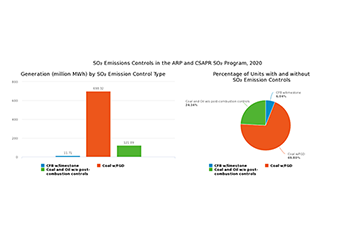
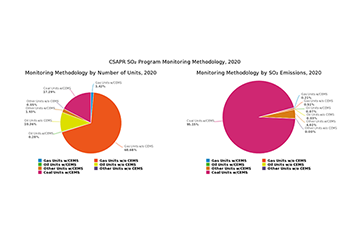
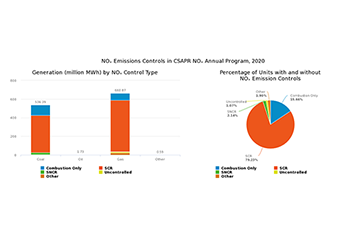
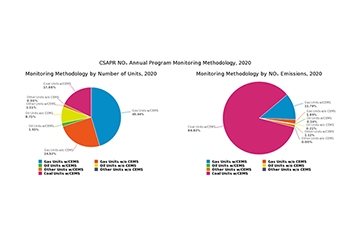
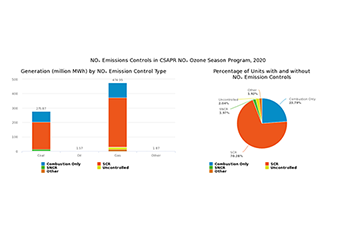
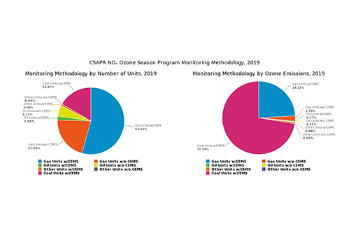
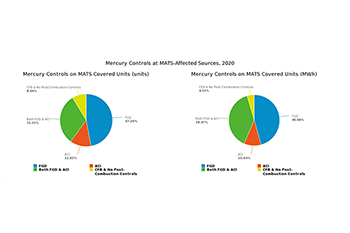
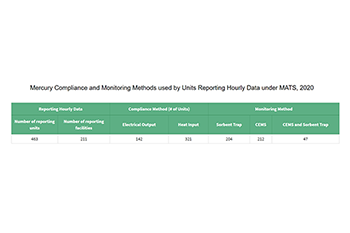
Highlights
ARP and CSAPR SO₂ Program Controls and Monitoring
- Units with advanced flue gas desulfurization (FGD) controls (also known as scrubbers) accounted for 79 percent of coal-fired units and 86 percent of coal-fired electricity generation, measured in megawatt hours, or MWh, in 2020.
- In 2020, 21 percent of the CSAPR units (including 100 percent of coal-fired units) monitored SO₂ emissions using CEMS. Ninety-nine percent of SO₂ emissions were measured by CEMS.
CSAPR NOₓ Annual Program Controls and Monitoring
- Eighty-one percent of fossil fuel-fired generation was produced by units with advanced add-on controls (either selective catalytic reduction [SCR] or selective non-catalytic reduction [SNCR]).
- In 2020, the 258 coal-fired units with advanced add-on controls (either SCRs or SNCRs) generated 78 percent of coal-fired electricity. At oil and natural gas-fired units, SCR- and SNCR- controlled units produced 84 percent of electricity generation.
- In 2020, 67 percent of the CSAPR units (including 100 percent of coal-fired units) monitored NOₓ emissions using CEMS. Ninety-eight percent of NOₓ emissions were measured by CEMS.
CSAPR NOₓ Ozone Season Program Controls and Monitoring
- Seventy-two percent of all the fossil fuel-fired generation was produced by units with advanced add-on controls (either SCRs or SNCRs).
- In 2020, 233 units with advanced add-on controls (either SCR or SNCR) accounted for 72 percent of coal-fired electricity generation. At oil- and natural gas-fired units, SCR- and SNCR-controlled units produced 72 percent of electricity generation.
- In 2020, 73 percent of the CSAPR units (including 100 percent of coal-fired units) monitored ozone season NOₓ emissions using CEMS. Ninety-seven percent of ozone season NOₓ emissions were measured by CEMS.
MATS Controls and Monitoring
- In 2020, forty-five percent of the MATS units reporting mercury emissions and 50 percent of the electricity generation at the MATS reporting units used activated carbon injection (ACI), a mercury-specific pollution control method to reduce mercury emissions and SO₂.
- About 82 percent of units that reported continuous mercury emissions data (or 82 percent of the total electricity generation from units that reported data) reported the use of advanced controls, such as wet scrubbers, dry scrubbers, or ACI, to reduce hazardous air pollutant emissions in 2020. These controls also reduce other pollutants, including SO₂. Some oil-fired units can meet the MATS emission limits through the use of particulate matter (PM) controls such as electrostatic precipitators (ESPs) or fabric filters (FFs).
Background Information
Continuous Emission Monitoring Systems (CEMS)
EPA has developed detailed procedures codified in federal regulations (40 CFR Part 75) to ensure that sources monitor and report emissions with a high degree of precision, reliability, accuracy, and timeliness. Sources are required to use CEMS or other approved methods to record and report pollutant emissions data. Sources conduct stringent quality assurance tests of their monitoring systems to ensure the accuracy of emissions data and to provide assurance to market participants that a unit of emissions measured at one facility is equivalent to a quantity measured at a different facility. EPA conducts comprehensive electronic and field data audits to validate the reported data. While some units with low levels of SO₂ or NOₓ emissions are allowed to use other approved monitoring methods, the vast majority of SO₂ and NOₓ emissions are measured by CEMS.
Under the MATS measurement regulations (40 CFR part 63), affected units can continuously measure emissions using CEMS for mercury, SO₂, hydrochloric acid (HCl), PM, and hydrofluoric acid (HF), or sorbent traps for mercury (Hg). Some qualifying units with low emissions can conduct periodic stack tests in lieu of continuous monitoring.
SO₂ Emission Controls
Sources in the ARP or the CSAPR SO₂ programs have a number of SO₂ emission control options available. These include switching to low sulfur coal or natural gas, employing various types of FGDs, or, in the case of fluidized bed boilers, injecting limestone into the furnace. FGDs – also known as scrubbers – on coal-fired electricity generating units are the principal means of controlling SO₂ emissions and tend to be present on the highest generating coal-fired units.
NOₓ Emission Controls
Sources in the ARP or the CSAPR NOₓ annual and ozone season programs have a variety of options by which to reduce NOₓ emissions, including advanced add-on controls such as SCR or SNCR, and combustion controls, such as low NOₓ burners.
Hazardous Air Pollutant Controls
Sources in MATS have a number of options available to reduce hazardous air pollutants (HAPs), including mercury, PM (a surrogate for toxic non-mercury metals), HCl, HF, and other acid gases. Sources can improve operation of existing controls, add pollution controls, and switch fuels (including coal blending). Specific pollution control devices that reduce mercury and HCl include wet FGDs (scrubbers), activated carbon injection (ACI), dry sorbent injection (DSI), and fabric filters.